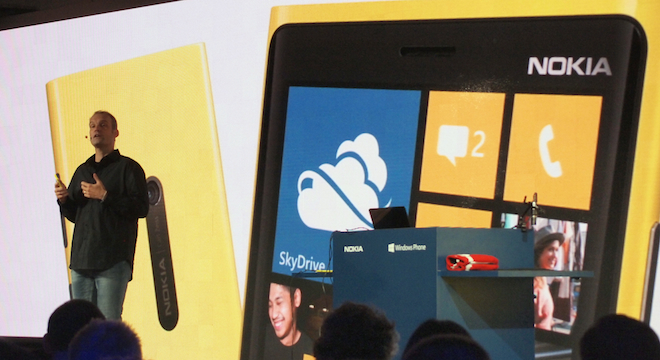Fall, when a young person’s fancy turns to smartphones.
That’s at least seems to be the thought of three companies: Apple, Nokia and Google’s Motorola, all of which have or are poised to unveil new smartphone models ahead of the winter holiday shopping season. A fourth company, HTC, also has a press event planned for September 19, but it’s unclear if it will be related to phones, tablets, or both.
Apple is widely anticipated to unveil the latest version of its best-selling device ever, the iPhone, at a press event in San Francisco scheduled for September 12.
But both Nokia and Motorola, the latter of which Google purchased in a $12.5 billion acquisition deal that closed in May, sought to steal some of Apple’s thunder: The two companies each held their own press events in New York City on Wednesday to debut their new lines of smartphones.
The question remains whether either company has a chance at breaking the Apple iPhone’s singular appeal on the U.S. market: Apple’s various versions of the iPhone account for 33 percent of the U.S. phone market, the single best-selling model from any company, according to the latest statistics from third-party market research firm comScore, though Google’s Android OS accounted for the overall market share as split by various devices.
“Clearly Apple is going to be a very strong competitor to all the other handsets announced and in the market,” said Ross Rubin, principal analyst and founder of Reticle Research, a consumer tech market research firm, in a phone interview with TPM. “Competition is definitely going to be strong as it ever has been during this fourth quarter.”
In the case of Nokia, the new devices are called the Lumia 920 and the Lumia 820, updates of its well-reviewed but commercially challenged Lumia line.
The Lumia 920 is pictured below in a Nokia press image:

“This represents Nokia’s second generation push into the U.S. smartphone market,” Rubin told TPM.
The two devices will run Microsoft’s upcoming Windows Phone 8 operating system and both boast some attractive new features such as a “PureView” camera system on the Lumia 920 for taking high-quality photos and easily editing and sharing them.
Microsoft is counting on Nokia’s phones to be its flagship for the new Windows Phone 8 operating system, as indicated by the brief appearance of Microsoft CEO Steve Ballmer at the Nokia event Wednesday.
“One thing that may help Nokia in particular this fourth quarter is that Microsoft is also releasing Windows Phone 8,” Rubin told TPM. “In addition to exposing more consumers to the “Live Tile” interface now on the desktop, Microsoft will be spending heavily to promote the operating system and presumably will be highlighting the commonalities of the interface [across phones and other devices.]”
But there were no concrete release dates or pricing announced during Nokia’s event, and the struggling Finnish phone-maker saw its stock drop following the announcement.
Worse still, one of Nokia’s new ads showing off the PureView camera was faked, as The Verge discovered, using a different camera to film a portion of the ad that appeared as though it was captured by the Lumia 920’s video camera. Nokia apologized and issued an updated video with authentic Lumia 920 footage.
Here’s the ad with the footage shot by a different camera:
And here’s the ad showing authentic footage shot with the Lumia 920:
Rubin noted that it wasn’t unusual for phone manufacturers to unveil devices without a firm release date, leaving it up to the carriers to make announcements about availability in their stores. He also doesn’t believe Nokia’s camera, or any phone’s, will be that much of a draw for consumers.
“Historically, we haven’t seen the camera as a major purchasing motivator among consumers,” Rubin said. “It’s not even in the top three.”
Instead, he said, “Nokia needs to focus on channel partners and carriers to drive sales.”
Meanwhile, Motorola offered up three new smartphones, the first of its Google era — all new versions of its hit Droid RAZR line: The Droid RAZR HD, the Droid RAZR Maxx and the Droid RAZR M, depicted in the following promotional image:

The new devices each boast some distinctive new features and will come with Google’s new Chrome for Android browser installed by default.
But all will also ship with an older version of Google’s Android operating system, which will be upgradable to the latest version, 4.1, or Jelly Bean, Motorola executives were quick to point out.
To sweeten the deal, Motorola also announced it would be giving a $100 credit to owners of any older Motorola phones that the company is unable to upgrade to Android Jelly Bean later this year. That too, has been criticized as being more of a marketing ploy than an earnest overture to help loyal Motorola customers.
Only one of the new Motorola Droid RAZR smartphones has pricing and release information: $99.99 for the Droid RAZR M at Verizon (after a $50 mail-in rebate), with Verizon taking pre-orders starting immediately and shipping the phone on September 13, when it appears in stores. The other two Motorola said would be available “before the holidays.”
Both Nokia’s and Motorola’s new phones that don’t have release dates will likely be available in the U.S. following the iPhone 5, Rubin noted.
Although Apple has not issued any information about the release date of a new iPhone, or even its name, for that matter, the company has a history of making its products available on or shortly after the date upon which it unveils them.
“The only major handset that should be in market that has significantly predated the new iPhone will be the Samsung Galaxy SIII,” Rubin said.
Samsung’s new flagship Android Phone was also recently reported to have outsold the iPhone in the month of August at most retailers where both are available in the U.S.






